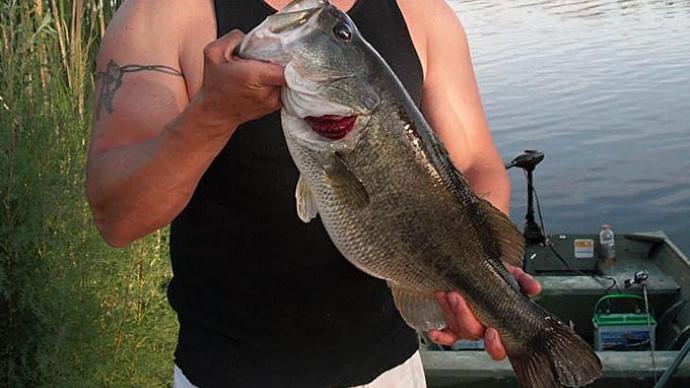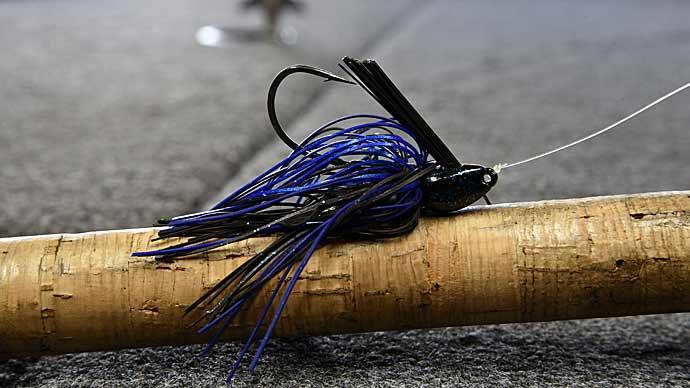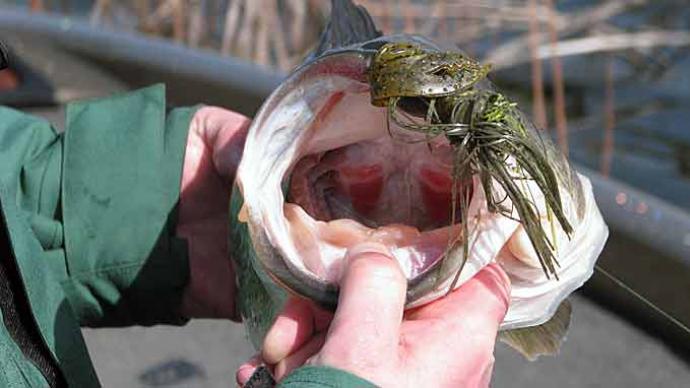
When you look closely at bass fishing throughout the year, there are times when certain baits excel and dominate specific seasonal periods. For example, stickbaits in the spring, crankbaits during the summer, and buzz baits in the fall, but one bait carries its domination all season long. That bait is a jig. Of all the baits we fish, the jig is such a versatile bait that it can be used all season long and fished in all conditions. Yes, I can take all the other bait examples and catch bass in the seasons mentioned above, but you can do better with a jig. So let's take a closer look at the adjustments you can make to catch fish on jigs all season long.
Jig Breakdown
When it comes to jigs, the head makeup of the jig is one of the essential parts. Yes, adjusting the hook style will make an impact, and I’ll touch on that, but the head style impacts your jig the most. So, taking a closer look, you could break the head style down by the season to put the odds in your favor. Then, when it comes to jig heads, you could stock the following few head styles into your mix and cover your bases throughout the year.
Bullet Head Jig
First up is what I call a bullet head jig. This head style makes the best weed jig in your arsenal and can also serve as a swim jig head. Because of unique needs when fishing a bullet head jig, I make most of the bullet heads to match the conditions in which I’m fishing them.
When stocking or making these jigs, pay special attention to the weed guard count. When using this head for a swim jig, you will want a lighter weed guard to help with lighter bite hookups. A lighter hook will also take less setting power than a heavier hook when it comes to swim jigs, resulting in more hookups than lost fish.
When faced with fishing in the weeds, I beef my jigs up with a higher count weed guard and a stout hook. These allow my jig to be fished in the weeds and have enough power to get the bass up and out of the weeds on the way back to the boat.
Arky Jig
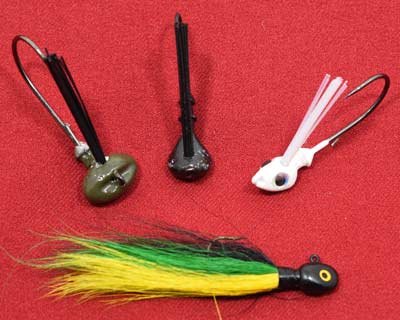
The Arky is fast becoming the sleeper jig in the mix, and a lot of that is because it's off the radar of the newer fishermen. But, yes, the older fishing generation is attuned to the Arky jig, as it has been a jig standard for many of the leading jig companies for years. Stanley and Strike King are a few that come to mind.
The Arky is a must-have jig head in your collection as I classify it as a go-between bullet head jig and a football jig head. The Arky jig excels where the bullet jig and the football jig lack. Weeds/rocks are a perfect example of this. In this case, you will have difficulty making enough contact with the bullet head and can’t get a football jig through the weeds, but an Arky jig will often get the job done without getting fouled or turning into a wasted cast.
Once again, follow what I talked about with the bullet jig regarding weed guard counts and hook choices. Stock both in your box and pick the appropriate jig for the time of the season or the conditions you’re fishing.
Football Jig Heads
The football jig head is the last one that I want to talk about. At certain times of the season, a football jig delivers a craw best and will generate more strikes when other craw-imitating jigs won’t. It’s especially true when fishing in cold water conditions during the spring and winter periods on the calendar. Craws at this time of the season can be few, and your presentation must be right on to trigger bites making the football jig the best way to deliver your craw.
Skirts
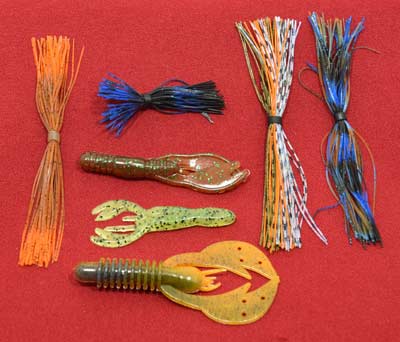
When fishing your jig through changing seasons, you must pay closer attention to the material of this skirt. In the past, fishermen bought jigs that were tied with skirts. That was early in the jig revolution when flat rubber was the only skirt material available. When fishing late into the season, it’s a material that you will want to try. The flat rubber material slows the jig's fall, helping keep your jig in the bite window longer, triggering strikes.
I keep a handful of flat rubber-skirted jigs on hand that I tie up, especially for the early and late parts of the season. Suppose you don't have any or can’t find any to purchase. I take a jighead matched to the conditions I’m fishing in and match it with a Lure Parts Online Star-Flash skirt. It’s not a flat rubber skirt. It's a round-strand silicone skirt. This skirt material acts close to a flat rubber skirt and will slow down your jig as it falls compared to thin silicone.
When it comes to skirts, stock the colors of the forage you’re trying to imitate. Also, include colors that have brighter accents to help get the jigs noticed and trigger bites.
Trailers
Pay special attention to the trailers you’re using when fishing in cold water, as this can make or break your bites. Therefore, you must match your trailers better to the water and bite conditions when you’re fishing in colder conditions.
Active bites use a trailer with a little glide movement when fishing. For example, I’ll use craws that have minimal movement in the claws. It will trigger more bites from active bass in the area.
If the bite is tough, I’ll pick a craw trailer with more craw action to its fall. The movement will slow the jigs' fall and help trigger more bites from inactive bass in the area.
Another is to upsize your trailer. Instead of using a 3" trailer, pick a 4" as your choice. The bigger trailer will slow your jig speed down, keeping your jig in the bite window longer, triggering more bites on its fall when needed.
Pay attention to the forage the bass are targeting, and pick your trailer appropriately. If the bass are keying in on baitfish, use a baitfish-imitating trailer. If it’s craws, use a craw imitation. Match the forage the bass are targeting with your jig.
One of the easiest ways is to use the same trailer but change the orientation of your trailer. If you’re trying to imitate a craw, use your craw in its regular rigging. If trying to imitate a baitfish, change the orientation of your craws to be vertical (up and down). It will imitate a tail of a bait fish when the jig is moved.
Hair Jigs
A hair jig is the sleeper of the group and one of the essential jigs. But, unfortunately, too many hair jigs are a blast from the past that don't get any attention. The main reason behind it is that fishermen who are still using hair with remarkable success keep quiet because they don't want others to know how well a hair jig still works.
I don’t know why hair jigs work so well, but I have a few thoughts. One is the natural movement of the hair as the jig falls and sits, looking like baitfish gills moving or slightly swimming, triggering bite along the way.
When it comes to trailers, one of the biggest tips I can give you is not to overpower the hair jig. I use a 4" ringworm as my main trailer, and I’m just using that as an accent color to put more color into my jig design. The only other trailer I'll use is a 3.6” Big Bite Scentsation SoMolly Worm if I’m looking to add scent to my mix in some off-colored water conditions.
Line Choices
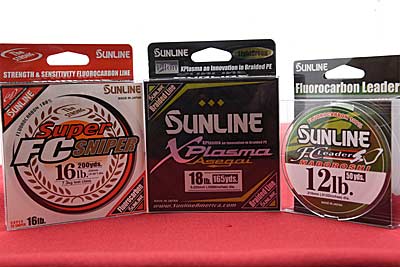
When faced with colder water temperatures, you may have to downsize your jig choice to keep it in the bite zone longer to trigger bites, so by adjusting your line choice, you can help facilitate this better and still get bass in the boat.
I’ll start with my typical choice in the cold water period: fishing 16lb Sunline Sniper FC as my main line choice. In cases when I may need to slow down my fall rate, I'll downsize my jig as a first move. That adjustment may change the feel of the jig depending on weather conditions. If I’m having difficulty keeping contact with the jig, I'll switch to a baitcaster spooled with 18lb Sunline Asegai braid teamed with a 12lb fluorocarbon Leader.
This adjustment will allow me to feel my jig better but may also work against me. I have had situations when I change to braid that not only can I feel the bass better, but they can also feel me and drop the jig before I get a chance to set the hook. In this case, I'll change out my fluorocarbon line and use monofilament, building a little stretch into the mix to get a second more to set the hook before that bass can drop the jig.
Even though the water may be at its lowest temperature of the year, bass will still bite a jig, but you will have to make a few changes along the way. When fishing in extreme conditions, you need to pay extra attention to how you’re fishing your jig and how the bass react to what you’re fishing.


